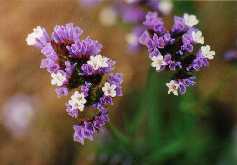Wildflowers
Photo gallery: Australian wildflowers
The purist might object to me calling all these 'wildflowers', some of them are Australian natives growing in gardens. I have concentrated on natives of Australia, although some of the flowers that I've photographed in the wild could well be ferals.The orchids were photographed by my older brother Robert. Photographs of other subjects are available via the home page.
|
Adelaide Region Clare Valley Crystal Brook Eyre Peninsula Far North of S.Aust. Western Australia Index
|
|
|
|
|
Clare Valley
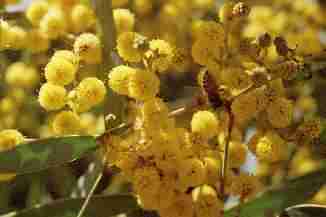
| You can click on some photos to see a larger copy. Use your back button to return. |
There is a bee gathering pollen. Wattle flowers are nectarless (Accacias of South Australia, Whibley & Symon), but the bees gather the pollen.
Many other trees at Elysium (Armagh, Clare, South Australia) are discussed
in
Clare trees.
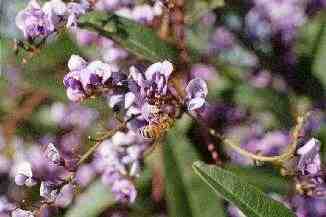 A native Hardenbergia violacea in a bush garden at 'Elysium'
near Armagh.
A native Hardenbergia violacea in a bush garden at 'Elysium'
near Armagh.
Again, there is a bee.
This is a fairly hardy plant, easy to grow, but it does need to be
watered in the Clare Summers to do well. It can do very well where
it can get its roots down a well, or where the water table is high
and the groundwater is not saline.

|
|
These climbers flower profusely, and for quite a long time,
around August and September each year.
 Kennedya nigricans, common name, black coral-pea, growing
at 'Elysium'.
Kennedya nigricans, common name, black coral-pea, growing
at 'Elysium'.
The flowers are mostly black, with some yellow. While this colour does not lead to spectacular displays, it is striking in its rarity.
It flowers around August and September and is a hardy native
climber.
|
|
Crystal Brook
Most of these are either in my own home garden, or in the garden around my office.
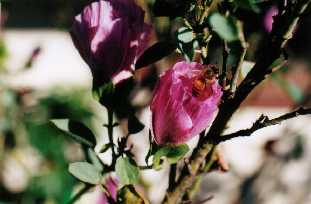 Sturt's Desert Rose, Gossypium sturtianum,
is the Northern Territory's floral emblem.
Apart from the NT it grows wild through the northern areas of South
Australia and is an easy shrub for the home gardener in the
agricultural districts of SA.
Sturt's Desert Rose, Gossypium sturtianum,
is the Northern Territory's floral emblem.
Apart from the NT it grows wild through the northern areas of South
Australia and is an easy shrub for the home gardener in the
agricultural districts of SA.
|
|
I love the contrast between the pink and the deep green.
 Hardenbergia violacea with Senna flowers in the background. I
planted both of these in the SA Water garden at Crystal Brook.
(Let's face it, if I don't do some gardening there, no one else will
do any!)
Hardenbergia violacea with Senna flowers in the background. I
planted both of these in the SA Water garden at Crystal Brook.
(Let's face it, if I don't do some gardening there, no one else will
do any!)

|
|
Unfortunately the shrub tends to become straggly and untidy as it gets
older.
 Another small tree (Callistemon) just outside of my office window.
The common name for this genus, appropriately, is bottlebrush.
Another small tree (Callistemon) just outside of my office window.
The common name for this genus, appropriately, is bottlebrush.

|
|
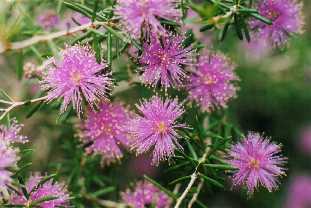 In the same garden is the Melaleuca tree that bears these blossoms.
In the same garden is the Melaleuca tree that bears these blossoms.
The Adelaide Region of South Australia
|
|
 A spider orchid in ?September 2001. This, also, was seen while
bushwalking in Hardie's scrub in the Onkaparinga Gorge.
A spider orchid in ?September 2001. This, also, was seen while
bushwalking in Hardie's scrub in the Onkaparinga Gorge.
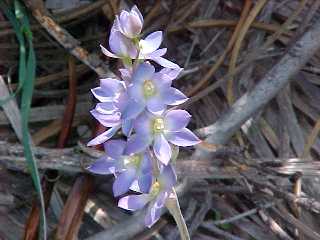 A sun orchid in ?September 2001. This was seen while bushwalking
in Hardie's scrub in the Onkaparinga Gorge.
A sun orchid in ?September 2001. This was seen while bushwalking
in Hardie's scrub in the Onkaparinga Gorge.
The Eyre Peninsula of South Australia
|
|
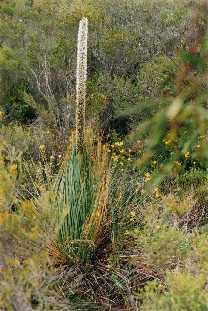 A yacca, Xanthorrhoea, flowering in October 2001 in the
Wanilla area. The leaves around the base are pulled into a bunch
by the snotty-gobble creeper wrapped around the yacca.
A yacca, Xanthorrhoea, flowering in October 2001 in the
Wanilla area. The leaves around the base are pulled into a bunch
by the snotty-gobble creeper wrapped around the yacca.
The snotty-gobble (otherwise known as slender devil's twine)
Cassytha glabella has very
fine stems and minute leaves. It is not visible in this photo.
 A close-up of the flower-head of the same yacca as that above.
A close-up of the flower-head of the same yacca as that above.
One can lick the nectar from the flowers. Aborigines used to obtain some of their sustenance this way.
I've written more about yaccas on another page.

|
|
It was on a creeper on roadsides in the Wanilla area.
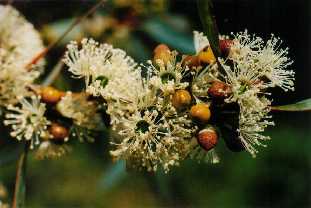 The mallee box, (Eucalyptus porosa), is common through much of
the cereal growing areas of South Australia.
The mallee box, (Eucalyptus porosa), is common through much of
the cereal growing areas of South Australia.
This one was in flower when I was working in the area in October 2001.
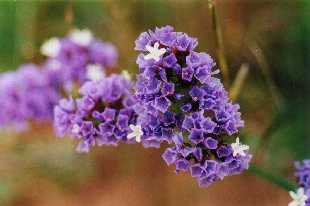 Fresh status; it looks little different when it has dried.
Found growing on the roadside near the Iron Duke mine. My reference
book indicates that its botanical name could be Limonium
latifolium, in which case it is a native to Bulgaria and the
Caucasus.
Fresh status; it looks little different when it has dried.
Found growing on the roadside near the Iron Duke mine. My reference
book indicates that its botanical name could be Limonium
latifolium, in which case it is a native to Bulgaria and the
Caucasus.
Far north of South Australia
|
|
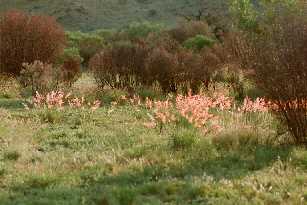 The flower-heads of these grasses seemed to be glowing!
Light from the lowering sun was shining through the feathery heads
and being scattered.
The flower-heads of these grasses seemed to be glowing!
Light from the lowering sun was shining through the feathery heads
and being scattered.
An example of how the right light can change a subject.
Western Australia
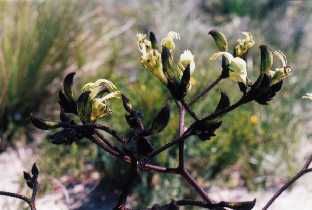 The floral emblem of Western Australia, the Kangaroo paw.
The floral emblem of Western Australia, the Kangaroo paw.
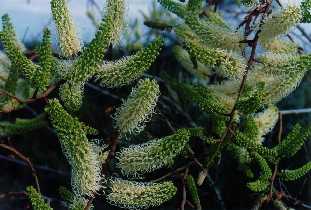
|
|
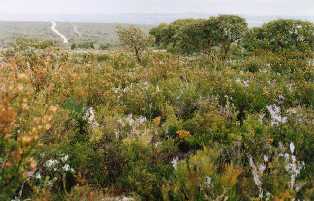 One doesn't seem to see such large displays of wide varieties
of wildflowers anywhere in Australia other than WA. This photo
was taken near Eniaba (inland of Geraldton).
One doesn't seem to see such large displays of wide varieties
of wildflowers anywhere in Australia other than WA. This photo
was taken near Eniaba (inland of Geraldton).
 Another photo in the same area. The soil here is very sandy.
Actually, the soil in most of the southern half of WA seems to be
sandy! (This is no more than a slight exaggeration; if it's not
sandy, it's lateritic, or very thin rubbly weathered granite.)
Another photo in the same area. The soil here is very sandy.
Actually, the soil in most of the southern half of WA seems to be
sandy! (This is no more than a slight exaggeration; if it's not
sandy, it's lateritic, or very thin rubbly weathered granite.)
